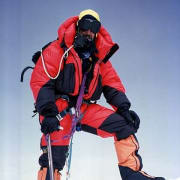Ukrainian Mountaineers Find Solace Forging New Route in the Himalayas

Success on New Route on Ama DaBlam
Ukrainian climbers Mykyta Balabanov and Mykhailo Fomin enjoyed victory and solace in the Himalayas, as war continues to disrupt their country and shatter the lives of so many. Legendary climber John Muir once said, ‘The Mountains are calling and I must go.’ Balabanov and Mykhailo heeded this cal,l and on November 1st summited pristine Ama Dablam via a new route on the West Face. Just three years ago when Russia invaded their country, they had conquered the Southeast Ridge of Annapurna III. In the face of such turmoil, sadness and challenge, the two elite alpinists have found their own peace tracking new lines while providing optimism and hope to their war-torn country.
The pair’s optimistic climbing goals for the fall season in the Himalaya were threatened by extreme weather conditions that hit Nepal in October. After battling arduous climbing from Base Camp to Advanced Base Camp on Makalu, they aborted their goal of forging a new route up the South Face of the mountain. Angela Benavides recently reported in an Article for ExplorersWeb about the climb. Balanbanov declared, “Just moving from Base Camp to Advanced Base Camp, which is usually a short day in running shoes, became a two-day [slog] through deep snow. In such conditions, it soon became clear that we were out of schedule to acclimatize properly for such a technical climb. There was simply no chance.”
They persevered in their quest to climb, and literally walked over the Sherpani Col (20,194 feet) and the Amphu Lapacha Pass (19,177 feet) to Ama Dablam (22,349 feet). “Yeah, it was an extra trip to add to the expedition,” the Ukrainians said. Once there, the team planned on a route up the South Face. Like their initial plan, this option also fell apart as the face was depleted of solid ice. “Global warming has completely changed the conditions on the face, which is more and more dangerous each year. Perhaps it would be possible in winter if there were enough snow, but not now,” Fomin noted.
The West Face met their expectations of an unclimbed route with much safer conditions. “It is not super-technical but rather moderate mixed terrain, with lots of rock climbing and some snow. After the rib, there is a characteristic rock barrier, which is one of the steepest parts of the route. All we could do was climb unprotected to the end of the pitch, then dig a hole in the snow with a shovel, sit there, and belay the other climber from that place. When the second climber reached that point, we shifted places, and the other climber would belay from the same hole, knowing the climber above him wouldn’t be placing any protection as he progressed,” said Balabanov.
The Pains of War
They continued to the top and made history, but with an emotional and difficult cost given the ongoing conflict in their county. In fact, on the day they summited Ama DaBlam’s West Face, their close friend died while fighting the war to remain independent. The fallen soldier’s nickname, Chegi, now adorns the once-unclimbed and unnamed route on Ama Dablam.
“We thought that even in times of war, our athletes should go to the Olympics,” Fomin said. “They should participate in international competitions, and we should climb again to show that the country is still alive despite all the suffering. Climbing is what we do, and it is our best option to show that Ukraine is still there.”
Ama Dablam
Ama Dablam, often referred to as the "Matterhorn of the Himalayas," is one of the most iconic and visually striking peaks in the world of mountaineering. Located in the Khumbu region of eastern Nepal, Ama Dablam, translates to "Mother's Necklace" in Sherpa language, with "Ama" meaning Mother and "Dablam" representing a pendant-like formation hanging from the mountain, resembling a traditional Sherpa double-pendant necklace containing pictures of the gods, worn by Sherpa women. The first successful ascent of Ama Dablam was made in 1961 by a team of mountaineers from New Zealand and the United States. (Related Article)
